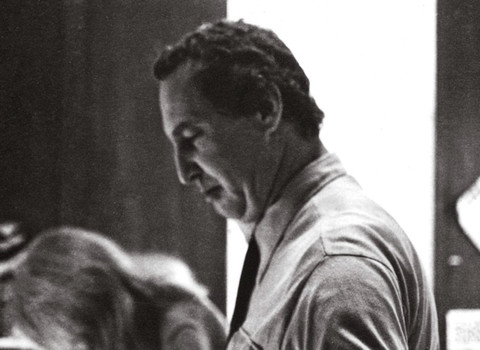This text was published to coincide with the Les Mason: Solo exhibition at NGV Australia, November 2015–February 2016.
Graphic designer and art director Les Mason was as much a successful designer in his own right as he was a provocateur, catalyst and protagonist in Melbourne’s burgeoning design scene. For more than thirty years, Mason demanded that the graphic design community and broader industry acknowledge the discipline as a fully formed profession, and that practitioners strive to offer rigorous conceptual and formal processes on par with other disciplines, such as architecture.
Born in California in 1924, Mason chose to study painting and interior design at the Chouinard Art Institute, Los Angeles, at the relatively late age of twenty-seven. Afterwards he began working in the world of commercial art and advertising as part of the small energetic design group West Coast Designers. In 1961 Mason successfully applied for a one-year contract as an art director at advertising agency USP Benson and relocated to Melbourne.
In Australia at the time, graphic design was still nascent as an independent practice. It was common for advertising agencies and printers to offer commercial art as a sub-service to advertising or print services, and they were primarily responsible for the creation of corporate identities, packaging, advertising and branding. As an outsider and talented typographer with a unique ability to conceptualise, create, visualise, iterate and communicate a full concept, Mason became indispensable at UPS Benson. His first award-winning campaign was a series of institutional advertisements for Shell Australia in 1962 in which he used unusual photography – a tabby cat with its head caught in an engine manifold – alongside catchy copywriting. The result was humorous, effective and memorable, and the campaign won the Shell Institutional Award for advertising.
Mason’s international outlook and design-led approach was informed by a love of contemporary art and international graphic design movements. He pushed creative boundaries and revealed that significant commercial and professional opportunities for more independent graphic design existed in Melbourne. He believed that solo studio practice would allow him to focus on the creation of rigorously conceived and executed design that would deliver a commercial advantage for clients while elevating society aesthetically.
The Les Mason Graphic Design studio opened in 1962 in South Melbourne and Mason set about building a practice that became synonymous with good design, discourse, debate, drinking and music. In the words of Denise Whitehouse:
*There are many variations on the story of how true Design arrives in Australia. Perhaps the most mythic of which is that of the arrival of the immigrant designer who … brings with them authentic design experience and knowledge. Within the regional backwaters of Australia they become luminaries, with the west coast American import, Les Mason, for example, being credited with breaking the dominance of conservative English ideas about ‘commercial art’ by promoting the idea and practice of ‘graphic design’ 1.
In 1966 Alan Holdsworth of Lawrence Publishing commissioned Mason to design a prestigious, bimonthly food and wine magazine named Epicurean for the Wine and Food Society of Australia. From 1966 until 1979 Mason designed seventy-seven issues of Epicurean, using his knowledge and love of geometric abstraction, colour field painting and Op Art to portray food and wine visually. To fit this low-fee project into his busy studio practice, Mason would arrive early to work to sketch concepts for Epicurean covers and internal pages before handing them on to the studio team. Often collaborating with artists, craftspeople and models, Mason devised unique designs for each new cover of magazine and often photographed them at home. Mason also constantly redesigned Epicurean’s masthead, exploring evolving typographic treatments alongside the publication’s creative concept.
At the height of his practice, Mason’s commercial clients represented some of Australia’s top consumer goods manufacturers. The list included Tarax, Bowater-Scott, Preservene, Comalco Aluminium, Wynvale Wines, Philip Morris and two major pharmaceutical producers, Sigma Laboratories and Woods Laboratories. This wide variety of clients demanded a versatile talent capable of responding to diverse briefs, products and consumer psychologies in order to create packages that offered a competitive commercial advantage for their brand. Mason was himself fascinated by the psychology of design, in particular the psychology of colour and gender in relation to consumer decision-making. He drew on these interests when designing hundreds of retail packages across diverse typologies.
In 1972 Frank Eidlitz, Garry Emery, Robert Rosetzky, Brian Sadgrove, Darrel Waddell and Lyn Waite published a book setting out the ideals of graphic design in Australia, including a fee structure and a code of ethics. 7 Australian Designers, 1970/1972 Number 1 arose from meetings after work when these designers would visit Mason’s studio to discuss the objectives of elevating the level of quality and professionalism of graphic design in Melbourne. The group served a pivotal role in forging a common code of ethics for designers and ensuring that clients better understood the importance and relevance of good design.
Mason was appointed a member of Alliance Graphique Internationale (AGI) and the Type Directors Club of New York in 1975. In 1981, he and his partner, the copywriter Gail Devine, relocated to Perth. There they were married and worked in their own consultancy for a number of years before travelling extensively and living in South America, where they both focused on their fine art practices. Les Mason died in Istanbul in 2009 while attending the AGI conference.
Ewan McEoin
